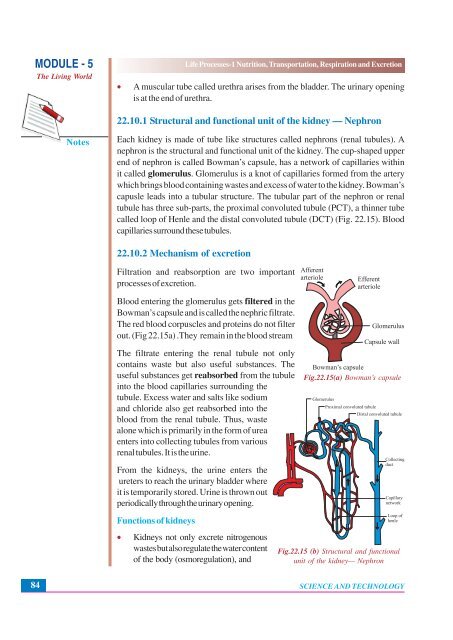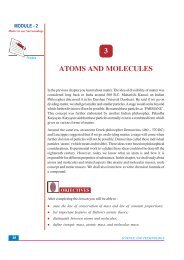Nutrition, Transportation, Respiration and Excretion
Nutrition, Transportation, Respiration and Excretion
Nutrition, Transportation, Respiration and Excretion
Create successful ePaper yourself
Turn your PDF publications into a flip-book with our unique Google optimized e-Paper software.
MODULE - 5<br />
The Living World<br />
Life Processes-1 <strong>Nutrition</strong>, <strong>Transportation</strong>, <strong>Respiration</strong> <strong>and</strong> <strong>Excretion</strong><br />
• A muscular tube called urethra arises from the bladder. The urinary opening<br />
is at the end of urethra.<br />
22.10.1 Structural <strong>and</strong> functional unit of the kidney — Nephron<br />
Notes<br />
Each kidney is made of tube like structures called nephrons (renal tubules). A<br />
nephron is the structural <strong>and</strong> functional unit of the kidney. The cup-shaped upper<br />
end of nephron is called Bowman’s capsule, has a network of capillaries within<br />
it called glomerulus. Glomerulus is a knot of capillaries formed from the artery<br />
which brings blood containing wastes <strong>and</strong> excess of water to the kidney. Bowman’s<br />
capusle leads into a tubular structure. The tubular part of the nephron or renal<br />
tubule has three sub-parts, the proximal convoluted tubule (PCT), a thinner tube<br />
called loop of Henle <strong>and</strong> the distal convoluted tubule (DCT) (Fig. 22.15). Blood<br />
capillaries surround these tubules.<br />
22.10.2 Mechanism of excretion<br />
Filtration <strong>and</strong> reabsorption are two important<br />
processes of excretion.<br />
Blood entering the glomerulus gets filtered in the<br />
Bowman’s capsule <strong>and</strong> is called the nephric filtrate.<br />
The red blood corpuscles <strong>and</strong> proteins do not filter<br />
out. (Fig 22.15a) .They remain in the blood stream<br />
The filtrate entering the renal tubule not only<br />
contains waste but also useful substances. The<br />
useful substances get reabsorbed from the tubule<br />
into the blood capillaries surrounding the<br />
tubule. Excess water <strong>and</strong> salts like sodium<br />
<strong>and</strong> chloride also get reabsorbed into the<br />
blood from the renal tubule. Thus, waste<br />
alone which is primarily in the form of urea<br />
enters into collecting tubules from various<br />
renal tubules. It is the urine.<br />
Fig.22.15(a) Bowman’s capsule<br />
From the kidneys, the urine enters the<br />
ureters to reach the urinary bladder where<br />
it is temporarily stored. Urine is thrown out<br />
periodically through the urinary opening.<br />
Functions of kidneys<br />
• Kidneys not only excrete nitrogenous<br />
wastes but also regulate the water content<br />
of the body (osmoregulation), <strong>and</strong><br />
Fig.22.15 (b) Structural <strong>and</strong> functional<br />
unit of the kidney— Nephron<br />
84<br />
SCIENCE AND TECHNOLOGY
















